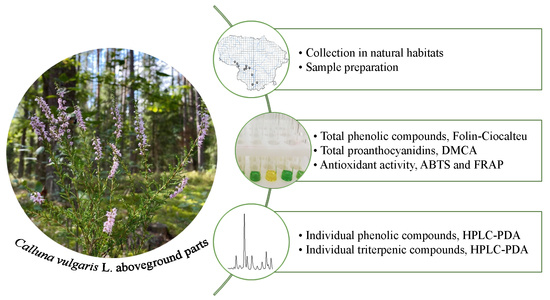Phytochemical Diversity and Antioxidant Potential of Wild Heather (Calluna vulgaris L.) Aboveground Parts
Abstract
1. Introduction
2. Results
2.1. Determination of Total Phenolic and Proanthocyanidin Content
2.2. Qualitative and Quantitative Analysis of Phenolic Compounds in Calluna vulgaris Samples
2.3. Qualitative and Quantitative Analysis of Triterpenic Compounds in Calluna vulgaris Samples
2.4. Antioxidant Activity of Heather Herb Extracts
2.5. Principal Component Analysis
3. Discussion
4. Materials and Methods
4.1. Chemicals and Solvents
4.2. Plant Materials
4.3. Sample Preparation
4.4. Determination of Total Phenolic Content
4.5. Determination of Total Proanthocyanidins Content
4.6. Determination of Antioxidant Activity
4.7. Qualitative and Quantitative Analysis by HPLC Method
4.8. Statistical Analysis
5. Conclusions
Supplementary Materials
Author Contributions
Funding
Institutional Review Board Statement
Informed Consent Statement
Data Availability Statement
Conflicts of Interest
References
- Navasaitis, M. Dendrologija; Margi Rastai: Vilnius, Lithuania, 2004; pp. 410–411. [Google Scholar]
- Navasaitis, M.; Ozolinčius, R.; Smaliukas, D.; Balevičienė, J. Lietuvos Dendroflora; Lututė: Kaunas, Lithuania, 2003; pp. 253–254. [Google Scholar]
- Chepel, V.; Lisun, V.; Skrypnik, L. Changes in the Content of Some Groups of Phenolic Compounds and Biological Activity of Extracts of Various Parts of Heather (Calluna vulgaris (L.) Hull) at Different Growth Stages. Plants 2020, 9, 926. [Google Scholar] [CrossRef] [PubMed]
- Monschein, M.; Neira, J.I.; Kunert, O.; Bucar, F. Phytochemistry of heather (Calluna vulgaris (L.) Hull) and its altitudinal alteration. Phytochem. Rev. 2010, 9, 205–215. [Google Scholar] [CrossRef]
- Szakiel, A.; Niżyński, B.; Pączkowski, C. Triterpenoid profile of flower and leaf cuticular waxes of heather Calluna vulgaris. Nat. Prod. Res. 2013, 27, 1404–1407. [Google Scholar] [CrossRef] [PubMed]
- Dróżdż, P.; Sentkowska, A.; Pyrzyńska, K. Biophenols and antioxidant activity in wild and cultivated heather. Nat. Prod. Res. 2017, 31, 1181–1184. [Google Scholar] [CrossRef]
- Starchenko, G.; Hrytsyk, A.; Raal, A.; Koshovyi, O. Phytochemical Profile and Pharmacological Activities of Water and Hydroethanolic Dry Extracts of Calluna vulgaris (L.) Hull. Herb. Plants 2020, 9, 751. [Google Scholar] [CrossRef]
- Rieger, G.; Müller, M.; Guttenberger, H.; Bucar, F. Influence of Altitudinal Variation on the Content of Phenolic Compounds in Wild Populations of Calluna vulgaris, Sambucus nigra, and Vaccinium myrtillus. J. Agric. Food Chem. 2008, 56, 9080–9086. [Google Scholar] [CrossRef]
- Sannikov, S.N.; Petrova, I.V.; Paule, L.; Egorov, E.V.; Cherepanova, O.E. Origin of the Atlantic Azorean insular population of Calluna vulgaris (L.) Hull. Curr. Plant Biol. 2019, 18, 100108. [Google Scholar] [CrossRef]
- García-Risco, M.R.; Vázquez, E.; Sheldon, J.; Steinmann, E.; Riebesehl, N.; Fornari, T.; Reglero, G. Supercritical fluid extraction of heather (Calluna vulgaris) and evaluation of anti-hepatitis C virus activity of the extracts. Virus Res. 2015, 198, 9–14. [Google Scholar] [CrossRef]
- Kalemba-Drożdż, M.C.A. Antioxidant and genoprotective properties of extracts from edible flowers. J. Food Nutr. Res. 2019, 58, 42–50. [Google Scholar]
- Vučić, D.M.; Petković, M.R.; Rodić-Grabovac, B.B.; Stefanović, O.D.; Vasić, S.M.; Čomić, L.R. In vitro activity of heather [Calluna vulgaris (L.) Hull] extracts on selected urinary tract pathogens. Bosn. J. Basic Med. Sci. 2014, 14, 234. [Google Scholar] [CrossRef][Green Version]
- Orhan, I.; Küpeli, E.; Terzioğlu, S.; Yesilada, E. Bioassay-guided isolation of kaempferol-3-O-β-d-galactoside with anti-inflammatory and antinociceptive activity from the aerial part of Calluna vulgaris L. J. Ethnopharmacol. 2007, 114, 32–37. [Google Scholar] [CrossRef] [PubMed]
- Ramadan, M.F.; Durazzo, A.; Lucarini, M. Advances in Research on Food Bioactive Molecules and Health. Molecules 2021, 26, 7678. [Google Scholar] [CrossRef]
- Vilkickyte, G.; Raudone, L.; Petrikaite, V. Phenolic Fractions from Vaccinium vitis-idaea L. and Their Antioxidant and Anticancer Activities Assessment. Antioxidants 2020, 9, 1261. [Google Scholar] [CrossRef] [PubMed]
- Mandim, F.; Barros, L.; Calhelha, R.C.; Abreu, R.M.V.; Pinela, J.; Alves, M.J.; Heleno, S.; Santos, P.F.; Ferreira, I.C.F.R. Calluna vulgaris (L.) Hull: Chemical characterization, evaluation of its bioactive properties and effect on the vaginal microbiota. Food Funct. 2019, 10, 78–89. [Google Scholar] [CrossRef]
- Rodrigues, F.; Moreira, T.; Pinto, D.; Pimentel, F.B.; Costa, A.S.G.; Nunes, M.A.; Albuquerque, T.G.; Costa, S.H.; Palmeira-de-Oliveira, A.; Oliveira, A.I.; et al. The phytochemical and bioactivity profiles of wild Calluna vulgaris L. flowers. Food Res. Int. 2018, 111, 24–31. [Google Scholar] [CrossRef] [PubMed]
- Ghareeb, D.A.; ElAhwany, A.M.D.; ElMallawany, S.M.; Saif, A.A. In vitro screening for anti-acetylcholiesterase, anti-oxidant, anti-glucosidase, anti-inflammatory and anti-bacterial effect of three traditional medicinal plants. Biotechnol. Biotechnol. Equip. 2014, 28, 1155–1164. [Google Scholar] [CrossRef]
- Starchenko, G.Y.; Grytsyk, A.R. Analysis of amino acid composition of Calluna vulgaris L. (Hull.). J. Pharm. Innov. 2017, 6, 88–89. [Google Scholar]
- Barros, L.; Dueñas, M.; Carvalho, A.M.; Ferreira, I.C.F.R.; Santos-Buelga, C. Characterization of phenolic compounds in flowers of wild medicinal plants from Northeastern Portugal. Food Chem. Toxicol. 2012, 50, 1576–1582. [Google Scholar] [CrossRef]
- Braghiroli, L.; Mazzanti, G.; Manganaro, M.; Mascellino, M.T.; Vespertilli, T. Antimicrobial activity of Calluna vulgaris. Phytother. Res. 1996, 10, 86–88. [Google Scholar]
- Alamgir, A.N.M. Therapeutic Use of Medicinal Plants and Their Extracts. In Therapeutic Use of Medicinal Plants and Their Extracts: Volume 1; Alamgir, A.N.M., Ed.; Springer Nature: Cham, Switzerland, 2017; pp. 453–495. [Google Scholar]
- Bezruk, I.; Marksa, M.; Georgiyants, V.; Ivanauskas, L.; Raudone, L. Phytogeographical profiling of ivy leaf (Hedera helix L.). Ind. Crop. Prod. 2020, 154, 112713. [Google Scholar] [CrossRef]
- Radušienė, J.; Janulis, V. Vaistinių ir aromatinių augalų įvairovės tyrimo, jų panaudojimo bei išsaugojimo tendencijos. Medicina 2004, 40, 705–709. [Google Scholar] [PubMed]
- Księżopolski, R.; Moré, E.; Olsanska, G.; De Paoli, A.; de Jongh, W.; Schunko, C.; Rode, J.; Moya, J.F.; Argyropoulos, D. Wild Collection: Recommendations to Avoid Over Exploitation and to Promote Sustainable Use of Wild Resources. Available online: https://ec.europa.eu/eip/agriculture/sites/default/files/fg35_mp5_wildcollection_2020_en.pdf (accessed on 10 June 2022).
- Cucu, A.A.; Baci, G.M.; Cucu, A.B.; Dezsi, S.; Lujerdean, C.; Hegedus, I.C.; Bobis, O.; Moise, A.R.; Dezmirean, D.S. Calluna vulgaris as a Valuable Source of Bioactive Compounds: Exploring Its Phytochemical Profile, Biological Activities and Apitherapeutic Potential. Plants 2022, 11, 1993. [Google Scholar] [CrossRef] [PubMed]
- Szakiel, A.; Paczkowski, C.; Pensec, F.; Bertsch, C. Fruit cuticular waxes as a source of biologically active triterpenoids. Phytochem. Rev. 2012, 11, 263–284. [Google Scholar] [CrossRef]
- Mandim, F.; Barros, L.; Heleno, S.A.; Pires, T.C.S.P.; Dias, M.I.; Alves, M.J.; Santos, F.F.; Ferreira, I.C.F.R. Phenolic profile and effects of acetone fractions obtained from the inflorescences of Calluna vulgaris (L.) Hull on vaginal pathogenic and non-pathogenic bacteria. Food Funct. 2019, 10, 2399–2407. [Google Scholar] [CrossRef]
- Rauf, A.; Imran, M.; Abu-Izneid, T.; Iahtisham-Ul-Haq; Patel, S.; Pan, X.; Naz, S.; Silva, A.S.; Saeed, F.; Suleria, H.A.R. Proanthocyanidins: A comprehensive review. Biomed. Pharmacother. 2019, 116, 108999. [Google Scholar] [CrossRef] [PubMed]
- Bladé, C.; Arola, L.; Salvadó, M.J. Hypolipidemic effects of proanthocyanidins and their underlying biochemical and molecular mechanisms. Mol. Nutr. Food Res. 2010, 54, 37–59. [Google Scholar] [CrossRef] [PubMed]
- Kasote, D.M.; Katyare, S.S.; Hegde, M.V.; Bae, H. Significance of Antioxidant Potential of Plants and its Relevance to Therapeutic Applications. Int. J. Biol. Sci. 2015, 1, 982–991. [Google Scholar] [CrossRef] [PubMed]
- Varga, E.; Becsek, E.; Bartha, S.G.; Stranczinger, S.; Mihalovits, F.; Papp, N. Determination of polyphenols and in vitro antimicrobial and antioxidant activity of Calluna vulgaris (L.) Hull. Biol. Futura 2021, 72, 251–256. [Google Scholar] [CrossRef]
- Escuredo, O.; Míguez, M.; Fernández-González, M.; Seijo, C. Nutritional value and antioxidant activity of honeys produced in a European Atlantic area. Food Chem. 2013, 138, 851–856. [Google Scholar] [CrossRef]
- Deliorman-Orhan, D.; Şenol, S.; Kartal, M.; Orhan, I. Assessment of antiradical potential of Calluna vulgaris (L.) Hull and its major flavonoid. J. Sci. Food Agric. 2009, 89, 809–814. [Google Scholar] [CrossRef]
- Vostinaru, O.; Dinte, E.; Soran, M.L.; Lung, I.; Opris, O.; Mogosan, C. Evaluation of the Anti-Gout Potential of Calluna vulgaris L. (Ericaceae) in Rats. Rec. Nat. Prod. 2018, 12, 432–444. [Google Scholar] [CrossRef]
- Blundell, R.; Azzopard, I.J.; Briffa, J.; Rasul, A.; Vargas-de la Cruz, C.; Shah, M.A. Analysis of pentaterpenoids. In Recent Advances in Natural Products Analysis; Elsevier: Amsterdam, The Netherlands, 2020; pp. 457–475. [Google Scholar]
- Wu, B.X.; Zhang, X.; Zhu, G.L.; Yang, X.Q.; Liu, Y.; Zhang, Y.J.; Zhao, P. Phenolic compounds and triterpenes from the roots of Vaccinium dunalianum Wight and their chemotaxonomic significance. Biochem. Syst. Ecol. 2021, 95, 104228. [Google Scholar] [CrossRef]
- Zeng, K.; Ban, S.; Cao, Z.; Cao, P.; Luo, X.; Wang, R.; Zhao, Z.; Xu, J. Phytochemical and chemotaxonomic study on the leaves of Rhododendron amesiae. Biochem. Syst. Ecol. 2021, 95, 104232. [Google Scholar] [CrossRef]
- Zhang, H.; Peng, X.; Zheng, X.; Li, S.; Teng, Y.; Liu, J.; Zou, C.; Yao, G. Lanostane triterpene glycosides from the flowers of Lyonia ovalifolia var. hebecarpa and their antiproliferative activities. Bioorg. Chem. 2020, 96, 103598. [Google Scholar] [CrossRef]
- Konieczynski, P. Principal component analysis in interpretation of the results of HPLC-ELC, HPLC-DAD and essential elemental contents obtained for medicinal plant extracts. Open Chem. 2013, 11, 519–526. [Google Scholar] [CrossRef]
- Saaby, L.; Rasmussen, H.B.; Jäger, A.K. MAO-A inhibitory activity of quercetin from Calluna vulgaris (L.) Hull. J. Ethnopharmacol. 2009, 121, 178–181. [Google Scholar] [CrossRef]
- European Soil Bureau Network European Commission. Soil Atlas of Europe; European Soil Bureau Network European Commission, Office for Official Publications of the European Communities: Luxembourg, 2005; 128p. [Google Scholar]
- Eidukeviciene, M.; Volungevicius, J.; Marcinkonis, S.; Tropolskaja, L.; Karcauskiene, D.; Fullen, M.A.; Booth, C.A. Interdisciplinary analysis of soil acidification hazard and its legacy effects in Lithuania. Nat. Hazards Earth Syst. Sci. 2010, 10, 1477–1485. [Google Scholar] [CrossRef][Green Version]
- Kottek, M.; Grieser, J.; Beck, C.; Rudolf, B.; Rubel, F. World Map of the KöppenGeiger climate classification updated. Meteorol. Z. 2006, 15, 259–263. [Google Scholar] [CrossRef]
- Slinkard, K.; Singleton, V.L. Total phenol analysis: Automation and comparison with manual methods. Am. J. Enol. Vitic. 1977, 28, 49–55. [Google Scholar]
- Prior, R.L.; Ji, E.F.H.; Howell, A.; Nio, C.; Payne, M.J.; Reed, J. Multi-laboratory validation of a standard method for quantifying proanthocyanidins in cranberry powders. J. Sci. Food Agric. 2010, 90, 1473–1478. [Google Scholar] [CrossRef]
- Re, R.; Pellegrini, N.; Proteggente, A.; Pannala, A.; Yang, M.; Rice-Evans, C. Antioxidant Activity Applying An Improved ABTS Radical Cation Decolorization Assay. Free Radic. Biol. Med. 1999, 26, 1231–1237. [Google Scholar] [CrossRef]
- Raudone, L.; Vilkickyte, G.; Pitkauskaite, L.; Raudonis, R.; Vainoriene, R.; Motiekaityte, V. Antioxidant Activities of Vaccinium vitis-idaea L. Leaves within Cultivars and Their Phenolic Compounds. Molecules 2019, 24, 844. [Google Scholar] [CrossRef] [PubMed]
- Benzie, I.; Strain, J. The Ferric Reducing Ability Of Plasma (FRAP) As A Measure Of “Antioxidant Power”: The FRAP Assay. Anal. Biochem. 1996, 239, 70–76. [Google Scholar] [CrossRef] [PubMed]
- Raudone, L.; Raudonis, R.; Liaudanskas, M.; Janulis, V.; Viskelis, P. Phenolic antioxidant profiles in the whole fruit, flesh and peel of apple cultivars grown in Lithuania. Sci. Hortic. 2017, 216, 186–192. [Google Scholar] [CrossRef]
- Raudone, L.; Puzerytė, V.; Vilkickyte, G.; Niekyte, A.; Lanauskas, J.; Viskelis, J.; Viskelis, P. Sea Buckthorn Leaf Powders: The Impact of Cultivar and Drying Mode on Antioxidant, Phytochemical, and Chromatic Profile of Valuable Resource. Molecules 2021, 26, 4765. [Google Scholar] [CrossRef]

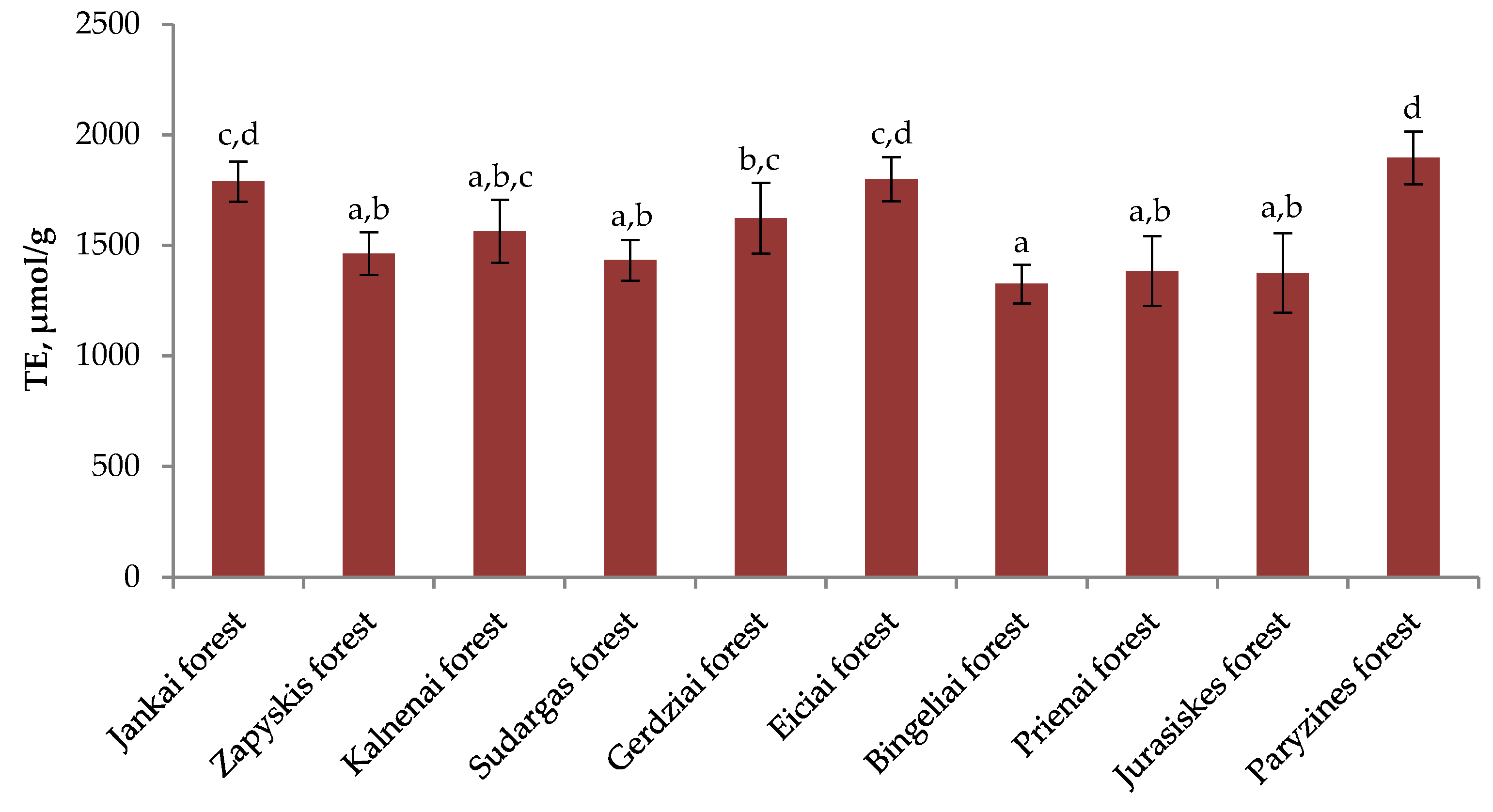
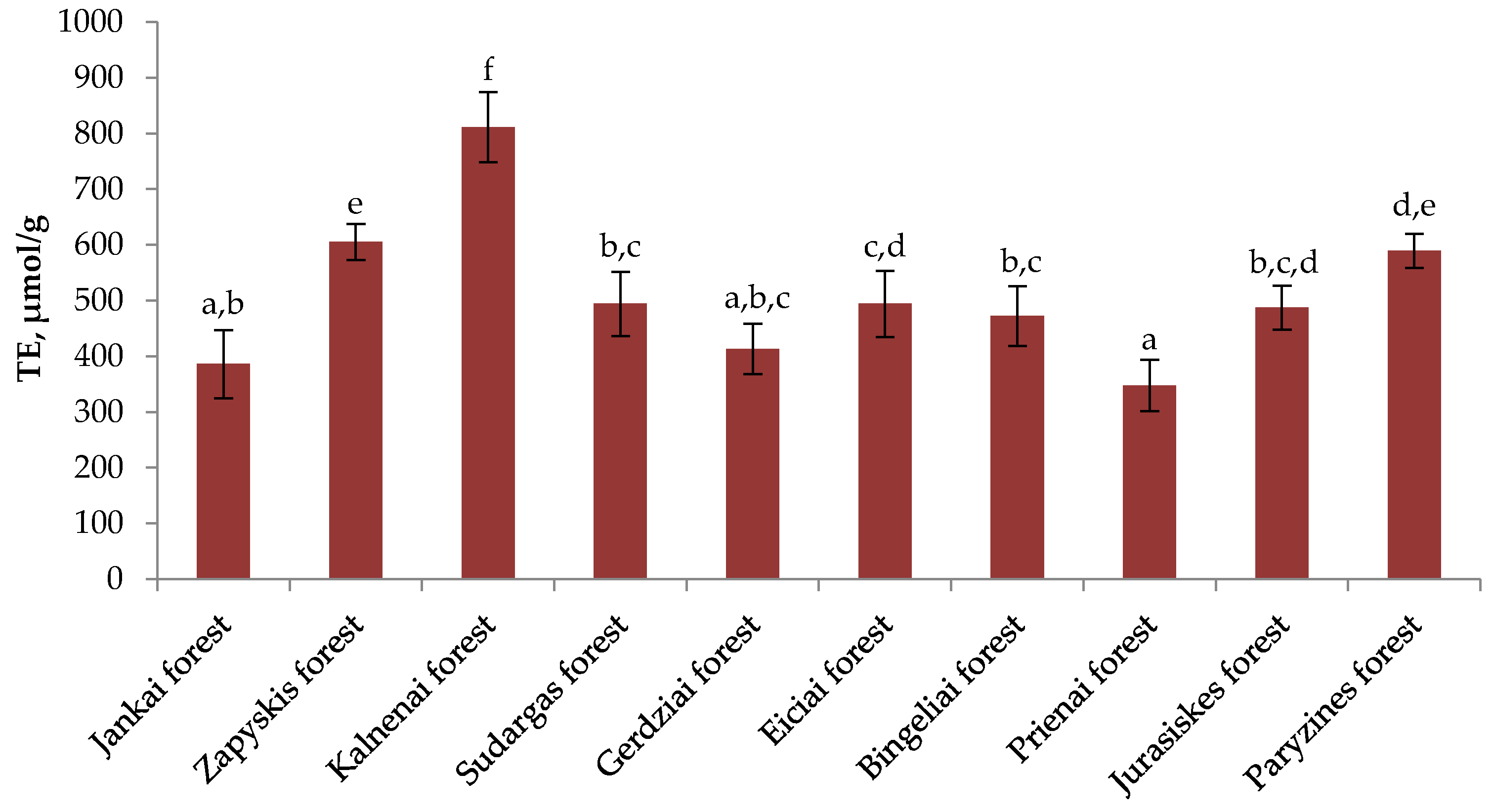
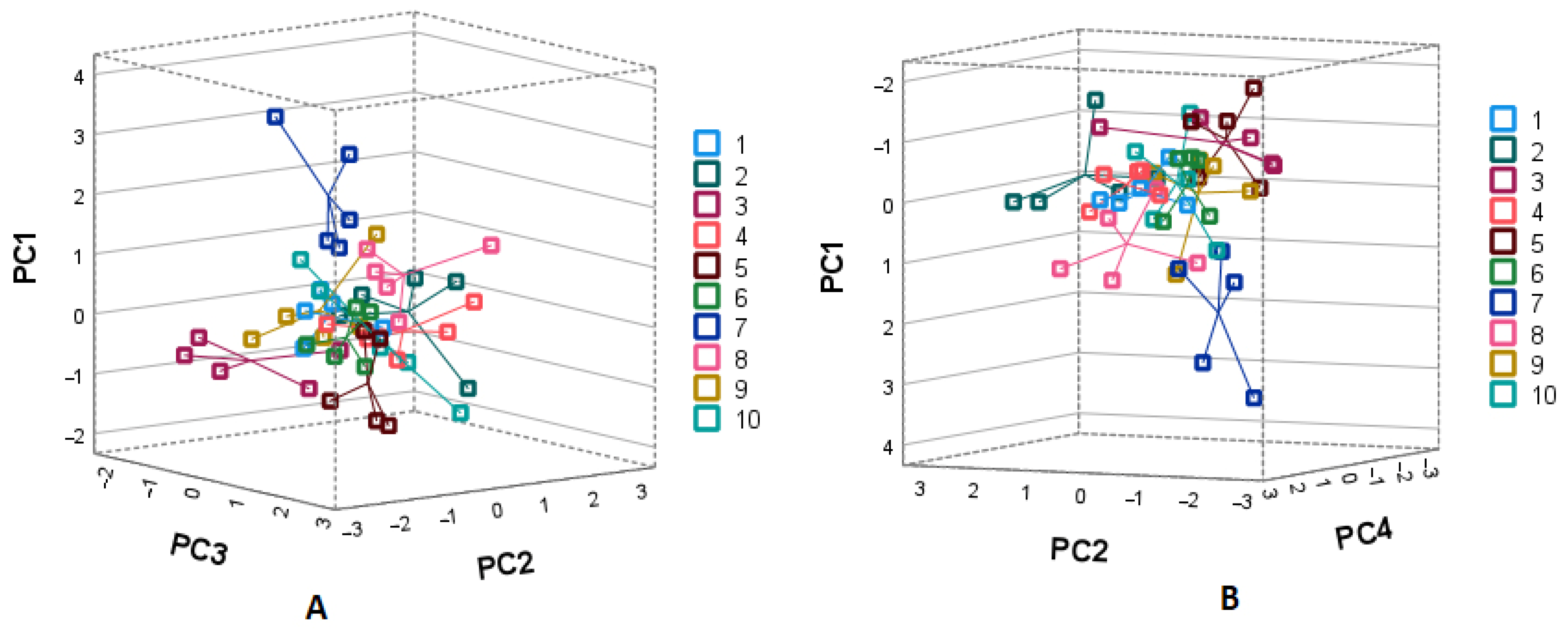
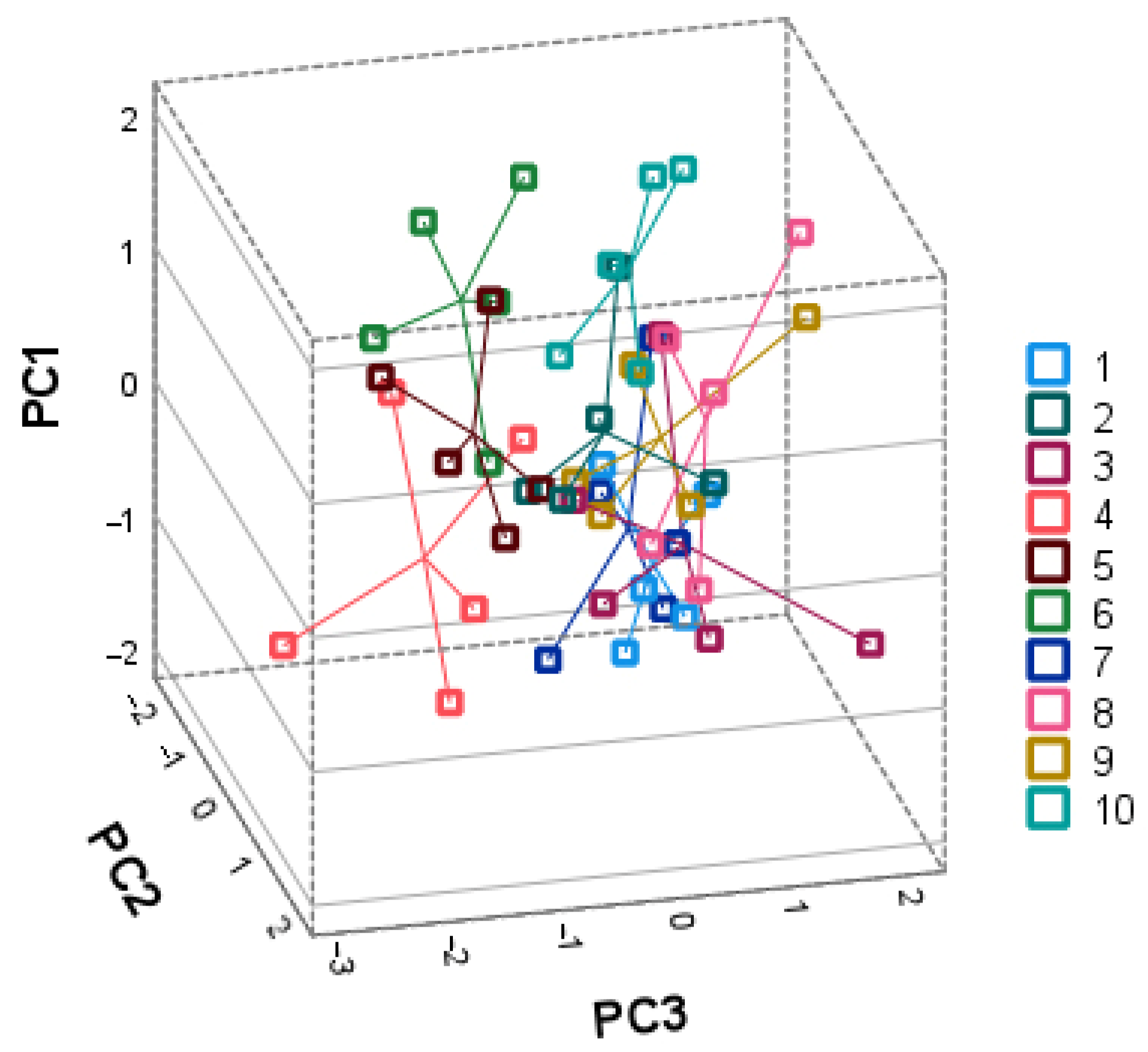
| Compounds | Jankai Forest | Zapyskis Forest | Kalnenai Forest | Sudargas Forest | Gerdziai Forest | Eiciai Forest | Bingeliai Forest | Prienai Forest | Jurasiskes Forest | Paryzines Forest |
|---|---|---|---|---|---|---|---|---|---|---|
| 4-O-caffeoylquinic acid | 176.07 ± 11.44 a 1 | 226.12 ± 24.72 a,b | 231.14 ± 17.22 a,b | 242.5 ± 10.97 a,b | 233.44 ± 6.79 a,b | 237.26 ± 10.85 a,b | 267.0 ± 14.23 b | 273.76 ± 17.89 b | 253.44 ± 9.96 b | 264.54 ± 18.23 b |
| 3,5-dicaffeoylquinic acid | 374.3 ± 58.86 a | 372.4 ± 86.46 a | 326.8 ± 58.18 a | 421.94 ± 78.84 b | 248.32 ± 42.80 a | 277.92 ± 58.07 a | 457.26 ± 102.50 b | 492.2 ± 15.69 b | 323.66 ± 28.01 a | 345.56 ± 71.21 a |
| Astragalin | 806.18 ± 129.36 a,b | 525.64 ± 95.29 a | 1208.9 ± 232.68 b | 471.68 ± 163.38 a | 342.14 ± 90.64 a | 733.64 ± 135.61 a,b | 756.36 ± 109.74 a,b | 819.58 ± 192.98 a,b | 671.80 ± 52.78 a,b | 555.6 ± 35.5 a |
| Avicularin | 846.2 ± 123.36 a | 1214.34 ± 126.55 a,b | 1094.86 ± 115.78 a,b | 1072.26 ± 164.56 a,b | 1054.68 ± 222.05 a,b | 1534.96 ± 116.88 a,b | 1282.44 ± 198.31 a,b | 1183.44 ± 204.25 a,b | 1255.28 ± 208.72 a, | 1728.04 ± 290.07 b |
| Caffeic acid | 45.52 ± 4.29 a | 43.28 ± 3.66 a | 45.74 ± 4.81 a | 47.46 ± 5.93 a | 50.42 ± 6.95 a | 46.58 ± 3.02 a | 48.28 ± 12.35 a | 44.34 ± 4.13 a | 49.88 ± 2.61 a | 47.28 ± 2.41 a |
| Chlorogenic acid | 9554.68 ± 586.39 ab | 7066.98 ± 1424.99 a | 9786.34 ± 1535.42 a | 10,091.6 ± 816.44 a | 7175.18 ± 481.35 a | 8480.86 ± 942.34 a | 8173.54 ± 1241.2 a | 9074.6 ± 1321.07 a | 10,238.18 ± 1043.83 a | 11,336.9 ± 1524.90 c |
| Epicatechin | 1464.82 ± 261.15 a | 625.78 ± 122.76 a | 1053.94 ± 299.08 a | 1416.68 ± 482.16 a | 957.96 ± 359.28 a | 637.4 ± 249.56 a,b | 1937.14 ± 461.25 a | 779.74 ± 238.67 a | 1110.24 ± 302.43 a | 514.12 ± 196.24 a,b |
| Hyperoside | 3609.42 ± 208.61 a | 3033.32 ± 374.82 a | 2529.54 ± 190.97 a | 2663.34 ± 544.71 a | 3507.5 ± 146.22 a | 3912.32 ± 141.09 a | 3186.9 ± 382.63 a | 3440.94 ± 634.53 a | 3729.24 ± 571.08 a | 3951.76 ± 340.93 a |
| Isoquercitrin | 1297.66 ± 72.26 a,b | 963.34 ± 94.09 a,b | 1369.8 ± 138.82 a,b | 814.64 ± 209.25 a | 1072.92 ± 142.29 a,b | 1400.48 ± 112.95 a,b | 1250.4 ± 127.19 a,b | 1706.94 ± 248.51 b | 1451.12 ± 278.59 a,b | 1118.88 ± 131.54 a,b |
| Kaempferol | 14.74 ± 0.86 a | 24.68 ± 4.48 a | 35.04 ± 7.52 a | 121.26 ± 15.50 b | 21.38 ± 8.92 a | 109.46 ± 21.33 b | 33.76 ± 3.62 a | 30.96 ± 5.63 a | 26.14 ± 1.9 a | 30.26 ± 5.36 a |
| Neochlorogenic acid | 2247.9 ± 336.44 a | 1805.94 ± 230.09 a | 2573.32 ± 308.81 a | 2372.76 ± 126.12 a | 2082.6 ± 305.16 a | 2281.88 ± 247.32 a | 2620.82 ± 286.24 a | 2589.66± 437.94 a | 2191.48 ± 254.42 a | 2256.62 ± 440.37 a |
| Proanthocyanidin A1 | 324.42 ± 23.48 a | 284.48 ± 13.98 a | 327.28 ± 32.46 a | 408.06 ± 77.94 a | 305.6 ± 46.62 a | 253.14 ± 34.29 a | 248.44 ± 46.72 a | 408.92 ± 82.54 a | 357.38 ± 55.37 a | 247.68 ± 24.55 a |
| Proanthocyanidin B2 | 1245.48 ± 102.53 a,b | 801.28 ± 81.31 a | 1121.42 ± 178.18 a | 1341.78 ± 124.06 b | 831.34 ± 74.83 a | 1029.22 ± 119.24 a,b | 1339.4 ± 277.51 b | 877.04 ± 87.27 a | 1258.4 ± 295.14 a,b | 944.16 ± 123.59 a |
| Proanthocyanidin B3 | 213.66 ± 3.57 a,b | 168.04 ± 23.03 a,b | 157.96 ± 29.06 a,b | 214.12 ± 17.05 a,b | 206.1 ± 3.95 a,b | 272.42 ± 65.51 b | 131.06 ± 19.75 a | 133.4 ± 15.49 a | 164.66 ± 20.85 a,b | 211.86 ± 27.07 a,b |
| Protocatechuic acid | 35.15 ± 1.74 a | 36.5 ± 4.41 a,b | 38.3 ± 3.56 a,b | 65.84 ± 11.13 b | 38.52 ± 3.45 a,b | 61.5 ± 11.45 a,b | 34.74 ± 3.56 a | 35.96 ± 2.79 a | 36.16 ± 3.99 a | 40.32 ± 7.36 a,b |
| Quercetin | 507.52 ± 43.86 a | 429.02 ± 35.12 a | 543.38 ± 88.63 a | 1338.56 ± 147.59 b | 601.04 ± 88.85 a | 1362.78 ± 145.48 b | 331.52 ± 38.81 a | 417.92 ± 28.71 a | 412.22 ± 32.06 a | 514.04 ± 54.34 a |
| Quercetin-3-arabinopyranoside | 511.46 ± 63.69 a | 646.06 ± 84.58 a,b | 614.44 ± 87.66 a,b | 583.22 ± 100.86 a,b | 664.22 ± 98.38 a,b | 906.98 ± 95.67 a,b | 736.7 ± 110.25 a,b | 623.2 ± 115.31 a,b | 821.7 ± 137.63 a,b | 1028.18 ± 163.54 b |
| Compounds | Jankai Forest | Zapyskis Forest | Kalnenai Forest | Sudargas Forest | Gerdziai Forest | Eiciai Forest | Bingeliai Forest | Prienai Forest | Jurasiskes Forest | Paryzines Forest |
|---|---|---|---|---|---|---|---|---|---|---|
| Oleanolic acid | 3794.29 ± 329.25 a | 4355.32 ± 184.21 a | 3527.23 ± 293.23 a | 4193.68 ± 242.22 a | 4795.64 ± 146.05 a | 4195.19 ± 300.38 a | 4570.66 ± 98.43 a | 4441.53 ± 375.90 a | 3818.73 ± 322.03 a | 3982.31 ± 428.49 a |
| Ursolic acid | 9700.96 ± 725.95 a,b | 9981.77 ± 292.59 a,b | 8181.79 ± 716.58 a | 10,379.29 ± 403.74 a,b | 9785.82 ± 580.90 a,b | 10,406.46 ± 460.76 b | 10,709.56 ± 391.94 b | 10,274.12 ± 273.65 b | 8915.74 ± 235.33 a | 9974.18 ± 296.99 a,b |
| Maslinic acid | 355.18 ± 46.79 a | 450.47 ± 43.82 a | 425.74 ± 70.48 a | 488.72 ± 90.69 a | 422.44 ± 80.12 a | 454,91 ± 56,70 a | 733.07 ± 100.81 a | 707.53 ± 153.45 a | 481.36 ± 103.75 a | 389.82 ± 69.30 a |
| Corosolic acid | 411.32 ± 50.61 a | 793.66 ± 191.37 a | 392.51 ± 53.59 a | 399.43 ± 38.82 a | 337.46 ± 79.38 a | 398.77 ± 52.42 a | 742.62 ± 168.13 a | 698.48 ± 165.27 a | 455.93 ± 82.62 a | 398.08 ± 73.66 a |
| Betulinic acid | 733.27 ± 85.81 a | 812.32 ± 149.08 a | 790.74 ± 143.59 a | 673.51 ± 84.45 a | 404.34 ± 86.42 b | 588.68 ± 83.97 a,b | 495.39 ± 66.38 b | 582.77 ± 176.33 a,b | 603.93 ± 88.12 a | 405.71 ± 49.54 b |
| Betulin | 355.15 ± 27.87 a,b,c | 462.04 ± 22.43 b,c | 518.46 ± 94.48 b,c | 422.98 ± 20.09 a,b,c | 551.69 ± 58.57 c | 433.46 ± 53.98 a,b,c | 244.71 ± 16.86 a | 361.80 ± 31.46 a,b,c | 316.62 ± 26.47 a,b | 381.36 ± 31.02 a,b,c |
| Erythrodiol | 233.86 ± 21.72 a,b | 323.25 ± 47.58 a,b,c | 164.56 ± 14.84 a | 397.07 ± 42.66 c | 310.99 ± 24.56 a,b,c | 255.74 ± 15.69 a,b,c | 225.18 ± 13.05 a,b | 249.41 ± 20.04 a,b,c | 255.49 ± 48.92 a,b,c | 329.15 ± 55.61 b,c |
| Uvaol | 1223.99 ± 207.77 a,b | 2450.64 ± 159.76 c | 917.87 ± 120.98 a | 1773.11 ± 159.82 b,c | 1187.79 ± 71.41 a,b | 1136.68 ± 113.51 a,b | 1570.03 ± 66.36 a,b | 1888.68 ± 339.91 b,c | 1254.48 ± 115.59 a,b | 1223.68 ± 203.67 a,b |
| Lupeol | 0.27 ± 0.27 a | 7.45 ± 4.36 a | 2.77 ± 2.01 a | 16.90 ± 6.82 a | 14.08 ± 3.54 a | 7.49 ± 1.38 a | 3.01 ± 2.01 a | 15.73 ± 2.63 a | 12.67 ± 9.29 a | 3.98 ± 2.59 a |
| β-Amyrin | 114.52 ± 8.71 a | 134.87 ± 14.59 a | 113.02 ± 13.43 a | 121.91 ± 14.31 a | 159.63 ± 23.19 a | 123.33 ± 13.75 a | 173.37 ± 24.82 a | 107.93 ± 16.76 a | 144.83 ± 8.6 a | 129.32 ± 23.16 a |
| β-Sitosterol | 382.73 ± 8.89 b | 321.65 ± 24.95 a,b | 315.13 ± 30.72 a,b | 372.94 ± 18.54 b | 279.63 ± 34.07 a,b | 304.59 ± 20.81 a,b | 251.83 ± 20.67 a | 344.09 ± 20.08 a,b | 300.93 ± 19.41 a,b | 334.61 ± 18.96 a,b |
| α-Amyrin | 475.05 ± 82.21 a,b,c | 912.15 ± 89.02 b,c | 224.87 ± 35.26 a | 731.46 ± 131.65 a,b,c | 545.07 ± 66.66 a,b,c | 415.99 ± 92.09 a,b | 375.68 ± 50.22 a,b | 1023.75 ± 282.95 c | 724.66 ± 86.65 a,b,c | 637.12 ± 64.63 a,b,c |
| Friedelin | 98.10 ± 23.68 a | 97.49 ± 13.36 a | 85.52 ± 20.86 a | 178.02 ± 20.08 a,b | 221.33 ± 45.37 b | 190.17 ± 24.22 a,b | 92.15 ± 18.84 a | 217.31 ± 23.59 b | 90.34 ± 11.08 a | 127.42 ± 30.28 a,b |
| Population Number | Heather Growth Site (Forest Name and Region) | Plant Raw Material Habitat | WGS Coordinates | Altitude |
|---|---|---|---|---|
| 1 | Jankai Forest (Kazlu Ruda municipality) | Forest | 54°49′, 23°22′ | 66.0 m |
| 2 | Zapyskis Forest (Kaunas district) | Outskirts | 54°54′, 23°38′ | 66.9 m |
| 3 | Kalnenai Forest (Jurbarkas district) | Outskirts | 55°04′, 22°41′ | 34.0 m |
| 4 | Sudargas Forest (Sakiai district) | Forest | 55°01′, 22°39′ | 42.1 m |
| 5 | Gerdziai Forest (Sakiai district) | Outskirts | 54°57′, 23°23′ | 70.9 m |
| 6 | Eiciai Forest (Taurages district) | Forest | 55°08′, 22°31′ | 42.7 m |
| 7 | Bingeliai Forest (Varenos district) | Forest | 54°09′, 24°16′ | 111.8 m |
| 8 | Prienai Forest (Prienai district) | Outskirts | 54°34′, 23°55′ | 106.4 m |
| 9 | Jurasiskes Forest (Druskininkai municipality) | Forest | 54°06′, 23°55′ | 135.3 m |
| 10 | Paryzines Forest (Sakiai district) | Outskirts | 54°57′, 23°22′ | 72.8 m |
Publisher’s Note: MDPI stays neutral with regard to jurisdictional claims in published maps and institutional affiliations. |
© 2022 by the authors. Licensee MDPI, Basel, Switzerland. This article is an open access article distributed under the terms and conditions of the Creative Commons Attribution (CC BY) license (https://creativecommons.org/licenses/by/4.0/).
Share and Cite
Kaunaite, V.; Vilkickyte, G.; Raudone, L. Phytochemical Diversity and Antioxidant Potential of Wild Heather (Calluna vulgaris L.) Aboveground Parts. Plants 2022, 11, 2207. https://doi.org/10.3390/plants11172207
Kaunaite V, Vilkickyte G, Raudone L. Phytochemical Diversity and Antioxidant Potential of Wild Heather (Calluna vulgaris L.) Aboveground Parts. Plants. 2022; 11(17):2207. https://doi.org/10.3390/plants11172207
Chicago/Turabian StyleKaunaite, Vytaute, Gabriele Vilkickyte, and Lina Raudone. 2022. "Phytochemical Diversity and Antioxidant Potential of Wild Heather (Calluna vulgaris L.) Aboveground Parts" Plants 11, no. 17: 2207. https://doi.org/10.3390/plants11172207
APA StyleKaunaite, V., Vilkickyte, G., & Raudone, L. (2022). Phytochemical Diversity and Antioxidant Potential of Wild Heather (Calluna vulgaris L.) Aboveground Parts. Plants, 11(17), 2207. https://doi.org/10.3390/plants11172207







